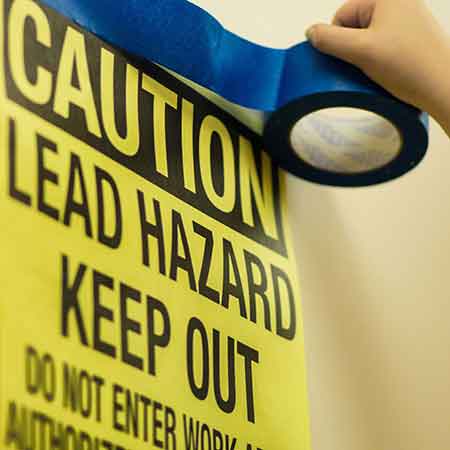A Breakdown of Lead Related Services
April 2022 – If you find yourself on the flipping / renovation / remodeling bandwagon, don’t let your excitement and deadlines distract you from basic yet important health and safety protocols.
Long before demo day, you should be thinking about PPE, work-area containment, and potential environmental hazards.

There are many harmful contaminants to consider during construction projects, and some are regulated by law, such as lead paint.
Lead is strictly regulated, and for good reason. Lead exposure can cause serious health effects, especially in young children. Studies show that lead poisoning causes damage to the nervous system, and a host of other issues in both children and adults.
Most in the construction industry are aware that any home or building built prior to 1978 is very likely to contain lead paint throughout the structure. When faced with the potential of lead paint in a building, however, there is much confusion surrounding what is required by law.

Understanding the nuances between Federal Law, State Law, and the requirements of a specific project can become overwhelming. At ARA, we get calls from seasoned contractors and engineers who still need clarification on the differences between a Lead Risk Assessment, a Lead Inspection, and a Lead Paint Survey.
When clients call for guidance, we always start by discussing these three key points:
- The lead regulations in the state the building is located (which may be stricter than EPA regulations);
- The specific legal requirements of the project (do you need a “Lead Safe” certificate for example); and
- The intended building use (because if children will occupy the space, lead laws are more rigorous).
Here is a breakdown of the types of services offered by certified lead professionals, and how they may or may not apply to your specific project:
Lead Risk Assessment
A Lead Risk Assessment is always required when the building will be occupied by children under the age of 6.

A Certified Risk Assessor assesses the lead exposure risk to children who might spend time in the space. A Risk Assessment involves a careful evaluation of all potential lead hazards. The Assessor will look for lead in:
- Paint
- Dust
- Soil
- Water
If you are required to provide any of the following, you must hire a Lead Risk Assessor
(a Lead Inspector cannot issue these documents)
- Lead Exposure Hazard Reduction Plan (LEHRP)
- Lead Safe Certificate
- Lead Compliance Certificate
The Lead Assessment must be performed by a person who has a valid Lead Risk Assessor’s license.
Lead Inspection
If you are performing demolition or renovation of a building that will not be occupied by children under 6 years old, you can request a Lead Inspection or a Lead Paint Survey (see next section).
A Lead Inspection, performed by a licensed Lead Inspector, includes testing for lead-based paint, evaluating the condition of the paint, and may also include dust, soil, and water sampling. Lead Inspectors can perform full inspections, preliminary inspections, and collect dust wipe samples.
As noted earlier, a Lead Inspector is not authorized to issue a Lead Safe Certificate, Certificate of Compliance, or write a Lead Hazard Reduction Plan (LEHRP).

Lead Paint Survey (aka Lead Determination)
If you simply need to evaluate whether or not the painted surfaces of the building contain lead, a more economical option would be to ask for a Lead Paint Survey. A Lead Survey, also referred to as a Lead Determination, is usually part of a hazardous materials (hazmat) survey prior to demolition or renovation.
During a Lead Paint Survey, painted components are tested for lead concentrations. A Lead Paint Survey does not include dust, soil, or water sampling (although these services may be requested, usually for an added cost).
A Lead Paint Survey does not fulfill Lead Safe or Hazard Reduction requirements; as mentioned earlier, a Lead Risk Assessor would be required for that.

Xray Fluorescence Analyzer (XRF) can detect lead in 26 layers of paint.
Summary
Renovating and upgrading a work or living space can be exciting, but don’t let your enthusiasm cloud your better judgement. Disturbing areas with lead paint is not only unwise, it is dangerous and can be illegal.
Per Federal Law, as of 2010, all contractors performing renovation, repair and painting projects that disturb more than six square feet of paint in homes, childcare facilities, and schools built before 1978 must be certified and trained to follow specific work practices to prevent lead contamination.
Ingesting, inhaling and touching lead dust is unsafe, so be sure you are approaching your project with care and forethought. Your state website should have plenty of information about lead guidelines as well as how to find a Certified Lead Professional in your area.
Helpful Links:
- EPA Lead Info & Regulations
- CDC Lead Health Effects
- Renovate Right Brochure from EPA
(Lead Hazard Info for Families, Child Care Providers & Schools) - ARA Lead Testing Services Page


